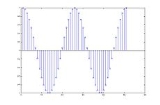
Discrete frequency
Encyclopedia
A discrete frequency domain is a frequency domain
that is discrete
rather than continuous
.
For example, the discrete Fourier transform
maps a function having a discrete time domain
into one having a discrete frequency domain. The discrete-time Fourier transform
, on the other hand, maps functions with discrete time (discrete-time signals) to functions that have a continuous frequency domain.
Frequency domain
In electronics, control systems engineering, and statistics, frequency domain is a term used to describe the domain for analysis of mathematical functions or signals with respect to frequency, rather than time....
that is discrete
Discrete space
In topology, a discrete space is a particularly simple example of a topological space or similar structure, one in which the points are "isolated" from each other in a certain sense.- Definitions :Given a set X:...
rather than continuous
Continuum (topology)
In the mathematical field of point-set topology, a continuum is a nonempty compact connected metric space, or less frequently, a compact connected Hausdorff topological space...
.
For example, the discrete Fourier transform
Discrete Fourier transform
In mathematics, the discrete Fourier transform is a specific kind of discrete transform, used in Fourier analysis. It transforms one function into another, which is called the frequency domain representation, or simply the DFT, of the original function...
maps a function having a discrete time domain
Discrete time
Discrete time is the discontinuity of a function's time domain that results from sampling a variable at a finite interval. For example, consider a newspaper that reports the price of crude oil once every day at 6:00AM. The newspaper is described as sampling the cost at a frequency of once per 24...
into one having a discrete frequency domain. The discrete-time Fourier transform
Discrete-time Fourier transform
In mathematics, the discrete-time Fourier transform is one of the specific forms of Fourier analysis. As such, it transforms one function into another, which is called the frequency domain representation, or simply the "DTFT", of the original function . But the DTFT requires an input function...
, on the other hand, maps functions with discrete time (discrete-time signals) to functions that have a continuous frequency domain.

